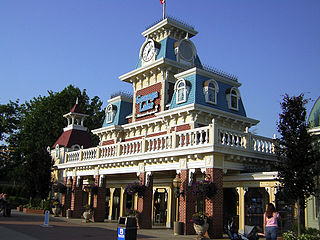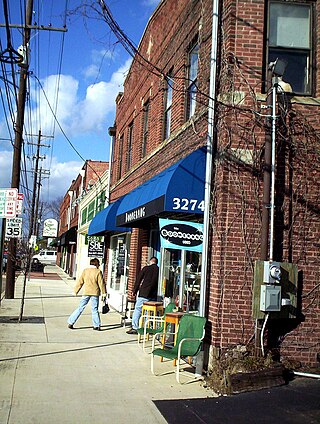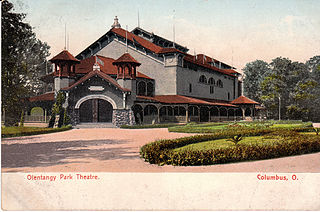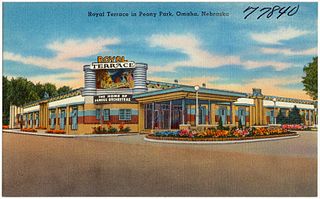
Kennywood is an amusement park which is located in West Mifflin, Pennsylvania, just southeast of Pittsburgh. The park opened on May 30, 1899, as a trolley park attraction at the end of the Mellon family's Monongahela Street Railway.

In the United States, trolley parks, which started in the 19th century, were picnic and recreation areas along or at the ends of streetcar lines in most of the larger cities. These were precursors to amusement parks. Trolley parks were often created by the streetcar companies to give people a reason to use their services on weekends.

Geauga Lake was an amusement park in Bainbridge Township and Aurora, Ohio. It was established in 1887, in what had been a local recreation area adjacent to a lake of the same name. The first amusement ride was added in 1889, and the park's first roller coaster – later known as the Big Dipper – was built in 1925. The park was sold to Funtime, Inc., in 1969 and was expanded over the years with additional rides and amenities. Funtime was acquired by Premier Parks in 1995, and for the 2000 season, they re-branded Geauga Lake as Six Flags Ohio, adding four new roller coasters. The following year, Six Flags bought the adjacent SeaWorld Ohio and combined the two parks under the name Six Flags Worlds of Adventure.

Clintonville is a neighborhood in north-central Columbus, Ohio, United States with around 30,000 residents. Its borders, associated with the Clintonville Area Commission, are the Olentangy River on the west, Glen Echo Creek to the south, a set of railroad tracks to the east, and on the north by the Worthington city limits.

Seabreeze Amusement Park (Seabreeze) is a historic family amusement park located in Irondequoit, New York, a suburb of Rochester, where Irondequoit Bay meets Lake Ontario. According to the National Amusement Park Historical Association (NAPHA), Seabreeze is the fourth-oldest operating amusement park in the United States and the thirteenth-oldest operating amusement park in the world, having opened in 1879. The park features roller coasters, a variety of other rides, a midway, and a water park.

Idora Park (1899–1984) was a northeastern Ohio amusement park popularly known as "Youngstown's Million Dollar Playground."

Olentangy Park was a trolley park, a type of amusement park, in Clintonville, Columbus, Ohio, operating from 1880 to 1937.
The University District, is a 2.8-square-mile (7.3 km2) area located 2 miles (3.2 km) north of Downtown Columbus, Ohio that is home to the main campus of Ohio State University, the Battelle Institute, and Wexner Medical Center. It is generally accepted as the area bounded to the north by Clintonville at Glen Echo Ravine; to the south by the Short North at 5th Avenue; to the west by the Olentangy River and to east by the Conrail railroad tracks. Points of interest include, but are not limited to, the Ohio Stadium and Old North Columbus. The district is Columbus' most densely populated area and contains more than 650 businesses, human service agencies, churches, and schools. University District businesses include boutiques, mixed retail, several tattoo studios, the Gateway Film Center, and a diverse range of restaurants and bars.

Ramona Park was an amusement park located in the city of East Grand Rapids, Michigan between 1897 and 1955. The Park included a double track wooden roller coaster, a theater pavilion, a ridable miniature railway and boat livery.

Luna Park was a trolley park in Cleveland, Ohio, USA, from 1905 to 1929.

Peony Park was an amusement park located at North 78th and Cass Streets in Omaha, Nebraska. Founded in 1919, over the next seventy-five years the 35-acre (140,000 m2) park included a 4.5-acre (18,000 m2) pool, beach and waterslide, a ballroom that billed itself as "1 acre under one roof," an open-air dance area for 3000 dancers, amusement rides, and various sundries. The park closed in 1994. Throughout its existence the park maintained its status as Nebraska's largest amusement park.

Luna Park was one of several names for an amusement park that existed in Rexford, New York, near Schenectady, from 1901 to 1933. In addition to Luna Park, it was also known as Dolle's Park, Colonnade Park, Palisades Park, and (again) Rexford Park before the rides were dismantled in 1933. Constructed around the Grand View Hotel, the park was similar to Ingersoll's other Luna Parks in which it was a trolley park with roller coasters, picnic pavilions, carousels, a fun house, a roller rink, a concert shell, a dance hall, a midway, a Whip, and a shoot-the-chutes ride which presented itself at the park entrance adjacent to a station of the Van Vranken electric trolley line. Roughly seven decades before the Skycoaster rides that now dot various United States amusement parks, Luna/Rexford Park featured an aerial swing ride.

Sunnyside Amusement Park was a popular amusement park in Toronto, Ontario, Canada that ran from 1922 to 1955, demolished in 1955 to facilitate the building of the Metro Toronto Gardiner Expressway project. It was located on the Lake Ontario waterfront at the foot of Roncesvalles Avenue, west of downtown Toronto.

Luna Park was an amusement park in the North Oakland neighborhood of the city of Pittsburgh, Pennsylvania, USA, from 1905 to 1909. Constructed and owned by Frederick Ingersoll, the park occupied a 16 acre hilly site bounded on the south by Atlantic Avenue and on the west by North Craig Street, and included roller coasters, picnic pavilions, carousels, a fun house, a Ferris wheel, a roller rink, a shoot-the-chutes ride, a concert shell, a dance hall, bumper cars, and a baby incubator exhibit. In its brief existence, the park featured regular performances of bands, acrobatic acts, animal acts, horse riders, and aerial acts.
Frederick Ingersoll was an American inventor, designer, builder and entrepreneur who created the world's first chain of amusement parks and whose manufacturing company built 277 roller coasters, fueling the popularity of trolley parks in the first third of the twentieth century. Some of these parks and roller coasters still exist today.
Known by a variety of names over its 101-year existence, Rocky Glen Park was a park near Moosic, Pennsylvania. Founded by Arthur Frothingham in 1886 as a picnic park, it was transformed into an amusement park by engineer and entrepreneur Frederick Ingersoll in 1904. The trolley park was a popular Pennsylvania attraction that featured rides, arcades, and restaurants – even as a "wild west" theme park in the 1970s – until its closure in 1987.
Riverside Amusement Park was an amusement park in Indianapolis, Indiana, US from 1903 to 1970. Originating as a joint venture between engineer/amusement park developer Frederick Ingersoll and Indianapolis businessmen J. Clyde Power, Albert Lieber, Bert Fiebleman, and Emmett Johnson, the park was built by Ingersoll's Pittsburgh Construction Company adjacent to Riverside City Park at West 30th Street between White River and the Central Canal in the Riverside subdivision of Indianapolis.
White City is the common name of dozens of amusement parks in the United States, the United Kingdom, and Australia. Inspired by the White City and Midway Plaisance sections of the World's Columbian Exhibition of 1893, the parks started gaining in popularity in the last few years of the 19th century. After the 1901 Pan-American Exposition inspired the first Luna Park in Coney Island, a frenzy in building amusement parks ensued in the first two decades of the 20th century.
Rock Springs Park is a defunct amusement park once located in Chester, West Virginia, Hancock County. The park officially began operation in 1897, and closed in 1970 after the death of its final owner, Robert Hand. After four years of disuse, the land was bought by the state of West Virginia for the rerouting of U.S. Route 30 and the construction of the Jennings Randolph Bridge over the Ohio River.
Vernon Keenan (1886-1964) was an American roller coaster designer best known for his involvement with the Cyclone at Coney Island.































